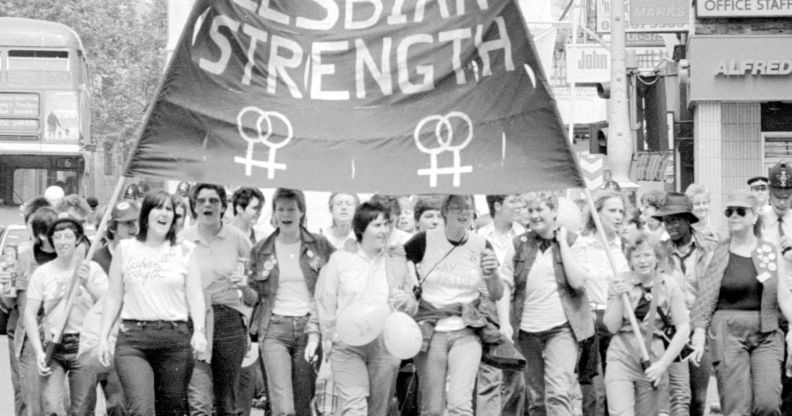Lesbian icon Lisa Power explains how AIDS crisis healed rift between lesbians and gay groups

The divide in the 1980s between lesbians and gay male groups is rarely discussed about, according to Lisa Power. (Getty)
Stonewall co-founder Lisa Power is tired of how lesbian activists are framed in historical accounts of the HIV crisis in the 1980s.
The storied LGBTQ+ veteran told PinkNews that while the pivotal changes established by groups like Stonewall and Switchboard for both the lesbian and queer groups could only have been achieved by working together, stories being told today don’t paint the full picture.
“All anyone ever thinks about is, first of all, AIDS, and then section 28,” Lisa said.
“In fact, there was a hell of a lot that went on that led to Section 28 and the rise of Stonewall.
“There is a story to be told of the insistence of lesbians to be taken seriously within the LGBTQ+ movement and to have our issues taken on board.
During the events that would culminate in the forming of Stonewall in 1989, Lisa’s unwavering desire to help those in need saw her working at the LGBT+ helpline Switchboard.
Being one of the only lesbian responders on the helpline at the time, she was exposed to the divide between gay men and lesbian groups that made it difficult to see eye-to-eye on certain topics.
Passive sexism against lesbians was ripe in queer circles
“I can remember on Switchboard there was a wide spectrum of attitudes towards lesbians from gay men. Although the vast majority of them were at least tolerant and vaguely supportive, and some were very actively supportive, you were barred from a lot of gay men’s clubs.
“There was quite a lot of fairly passive sexism, which was around gay men who said, ‘Well, I suppose we ought to have lesbians in here,’ and then there was the active misogyny.
“For example, when we started the Pink Paper, there were gay men’s bars that wouldn’t advertise with us because ‘fish’ – which is what they called women – would see the ads and weren’t welcome.
“The assumption was that lesbians started fights and that gay men didn’t,” Lisa continued.
“There was just sort of a sense that they didn’t want us around.”
A lot of the rift between gay men and lesbian groups in the lead-up to Stonewall’s founding was predominantly due to what Lisa said was a misogynistic undertone to a lot of activism at the time.
She explained that, especially in the late 70s and early 80s, sexism was “absolutely standard” and, as a result, many lesbians felt rejected from activist groups.
The segregation between groups wasn’t exactly new at the time. Having travelled to London in the late 70s, Lisa recalled the attempts by lesbians to separate themselves from mixed-sexuality groups due to the misogynistic undertone present in certain circles.
“An awful lot of lesbians had walked out of mixed organisations to found lesbian-only ones. But for me, it was quite clear that it was the male-dominated mixed organisations which had what power was there.”
HIV crisis a pivotal moment for lesbians and gay men
Things changed dramatically following the beginning of the HIV crisis, however. The shocking rise in infections prompted reluctant separatists to extend the olive branch to those like Lisa who had been attempting to mend the rift between gay and lesbian activists for years.
“It was seen as a community issue for a lot of us,” Lisa said. “It became very clear that some men did welcome lesbians.
“There’s a history across the 80s of things slowly relabeling themselves from gay to lesbian and gay… For example, Switchboard renamed itself to lesbian and gay Switchboard when it didn’t have more than six to eight lesbians involved, but it was a declaration of intent.
“There were quite a few gay men who did begin to appreciate lesbians and indeed women for getting stuck in around AIDS. But I think, again, I mean the narrative that somehow they granted us access because we’d been handmaidens is not really what happened.”
Despite the increased alliance between lesbian-only and mixed-sexuality groups, there were still fringe efforts to use HIV as an excuse to separate people further.
“There were lesbian separatists who leveraged [the HIV pandemic] as an issue to say, ‘look, this is why you don’t hang out with men.’
“AIDS [also] contributed a lot to biphobia, which was already there, but AIDS was an ultra-convenient excuse and a concrete one because people were genuinely scared. The tombstone ads in the mid-80s put the fear of God into most of the population.”
But overall, the imposing threat of both a virus about which there was little information and the resulting institutional discrimination lay the foundation for what would see the queer community band together to fight back.
“We can all do some organising amongst our own groups, but at the same time, there’s a real need for us all to work together,” Lisa continued.
“That wasn’t the case in the 80s. The 80s is a story of lesbians basically kicking the door down on gay men’s organisations and saying, ‘Hello, you’re going to share.’
“I think most queer people now recognise that we’re must stronger together than apart.”

